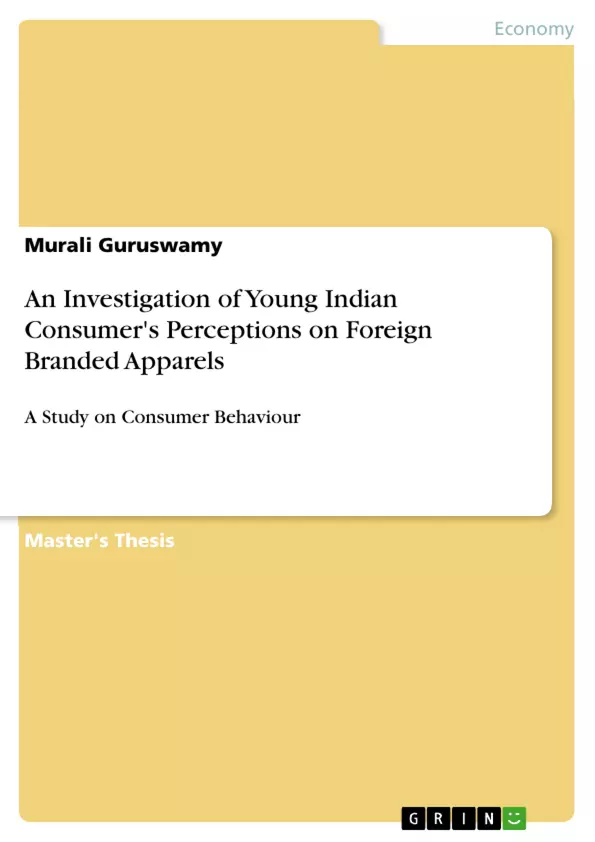The study is based on analyzing young Indian’s perceptions on foreign branded apparels and analysis of Indian youth customer’s behavior. The investigation primarily aimed at analyzing young Indian customer’s behavior and exploring the relation between them with foreign branded apparels. It also included the theoretical study of Brands & Brand Management and the key drivers that has a likely impact on customer’s behaviors, which used Indian young customers as target participants for the study. The study finalizes that fact that brands have significant impact of customer’s behavior by outlining the key drivers that would enable gradual sales for organizations, by presenting various theories, models, and methodologies to arrive at a conclusion.
In the theoretical part of the study, the researches makes a prompt attempt to explore the relationship between consumer behaviors and brands considering the influential factors acting upon the mindsets of the customer’s. The consumer’s decision-making abilities and process are subjected with brands elements and factors that would build effective global brands to fulfill the objectives of the study and arrive at conclusion.
Findings from theoretical and practical analysis determines that the global brands managers should realize that building brands on target customer bases and their perceptions would contribute to the growth of their businesses. The study also outlines that fact that, young generations are more attracted towards the brands rather than the products they purchase.
The study also confirms that, consumer behaviors are subjected to brand perceptions and among the targeted Indian young Indian customers; brands play a significant role in facilitating the purchase decision. These facts are the empirical evidences provided by 102 participants of the survey and 38 industry and retail experts who took place in interviews conducted by the researcher.
Finally, the study outlines recommendations for the readers and brand marketers stating; brands are the intangible building tools of organization and global firms operating in India should consider the young generations as their major source of customer bases and design their strategies that would cater all the young customers irrespective of locations in India.
Table of Contents
- DECLARATION
- ACKNOWLEDGEMENT
- ABSTRACT
- CHAPTER 1: INTRODUCTION
- 1.1 Background of the Study
- 1.2 Problem Statement
- 1.3 Research Objectives
- 1.4 Research Questions
- 1.5 Significance of the Study
- 1.6 Scope of the Study
- 1.7 Limitations of the Study
- 1.8 Organization of the Study
- CHAPTER 2: LITERATURE REVIEW
- 2.1 Introduction
- 2.2 Consumer Behavior
- 2.3 Brand Management
- 2.4 Global Branding
- 2.5 Indian Consumer Market
- 2.6 Foreign Branded Apparels in India
- 2.7 Conclusion
- CHAPTER 3: RESEARCH METHODOLOGY
- 3.1 Introduction
- 3.2 Research Design
- 3.3 Data Collection Methods
- 3.4 Sampling Technique
- 3.5 Data Analysis Techniques
- 3.6 Ethical Considerations
- 3.7 Conclusion
- CHAPTER 4: FINDINGS AND ANALYSIS
- 4.1 Introduction
- 4.2 Demographic Profile of Respondents
- 4.3 Perceptions of Foreign Branded Apparels
- 4.4 Factors Influencing Purchase Decisions
- 4.5 Brand Loyalty and Brand Switching
- 4.6 Conclusion
- CHAPTER 5: DISCUSSION AND RECOMMENDATIONS
- 5.1 Introduction
- 5.2 Discussion of Findings
- 5.3 Recommendations for Brands
- 5.4 Future Research Directions
- 5.5 Conclusion
- REFERENCES
Objectives and Key Themes
The dissertation aims to investigate the perceptions of young Indian customers towards foreign branded apparels. It explores the factors that influence their purchasing behavior and the relationship between brand perceptions and customer decision-making. The study utilizes theoretical frameworks of brand management and consumer behavior to analyze the impact of global brands on the Indian market.- Consumer behavior and its relationship with brand perceptions
- The role of global brands in shaping consumer preferences
- Factors influencing purchase decisions for foreign branded apparels
- The impact of brand loyalty and brand switching on customer behavior
- Recommendations for brands operating in the Indian market
Chapter Summaries
- Chapter 1: Introduction This chapter sets the context for the study by introducing the research problem, objectives, and significance. It provides background information on the Indian apparel market and the growing popularity of foreign brands among young consumers. The chapter also outlines the scope, limitations, and organization of the study.
- Chapter 2: Literature Review This chapter reviews relevant literature on consumer behavior, brand management, global branding, and the Indian consumer market. It explores the theoretical frameworks and empirical findings related to the study's focus areas. This chapter aims to establish a foundation for understanding the existing knowledge and identify gaps that the dissertation seeks to address.
- Chapter 3: Research Methodology This chapter details the research design, data collection methods, sampling technique, data analysis techniques, and ethical considerations involved in the study. It explains the procedures used to gather and analyze data, ensuring the reliability and validity of the findings. This chapter aims to provide a transparent and replicable account of the research process.
- Chapter 4: Findings and Analysis This chapter presents the findings of the study based on the collected data from surveys and interviews. It analyzes the perceptions of young Indian customers towards foreign branded apparels and examines the factors that influence their purchasing decisions. This chapter presents a detailed analysis of the data and explores the relationships between different variables.
Keywords
This dissertation focuses on the intersection of consumer behavior, brand management, and global branding within the context of the Indian apparel market. Key terms include: foreign branded apparels, young Indian customers, consumer behavior, brand perception, purchase decisions, brand loyalty, brand switching, global branding strategies.- Quote paper
- MBA Murali Guruswamy (Author), 2014, An Investigation of Young Indian Consumer's Perceptions on Foreign Branded Apparels, Munich, GRIN Verlag, https://www.grin.com/document/271075



